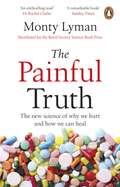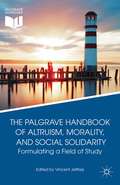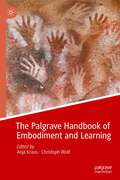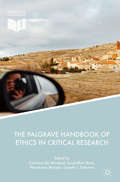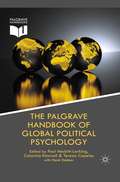- Table View
- List View
The Pain of Suicide: A Phenomenological Approach To Understanding 'Why?'
by Dr Jo-Ann RowlandEvery suicide is an individual tragedy whose origins challenge our mental capacity. Suicide is a global phenomenon. Each year there are over 800,000 reported suicides worldwide and that is expected to increase to over 1.5 million by 2020. More people attempt suicide than die from suicide. Family-member survivors and communities are left with many unanswered questions, not understanding why the person chose to commit suicide. Persons responding to suicide and suicide attempts are very often not prepared for what they encounter and this exacerbates the problem. This book looks at the struggles of a high-risk people group and presents interventions and postventions proffered in a consultation forum.
Pain Psychology for Clinicians: A Practical Guide for the Non-Psychologist Managing Patients with Chronic Pain
by Leanne R. Cianfrini Elizabeth J. Richardson Daniel DoleysGiven the heightened focus on the opioid crisis and its intersection with adequate chronic pain management, there is an impetus to shift patient care toward self-management and comprehensive interdisciplinary modalities. However, despite the evidence base for efficacy, pain psychology remains largely relegated to the complementary and alternative medicine designations and medical providers struggle to search for trained pain psychologists in their community. This unique book makes core psychological techniques accessible to medical providers and allied health professionals who are on the front lines of routine communication with patients living with chronic pain. Practical suggestions and vignettes demonstrate how to briefly and effectively incorporate key concepts from Cognitive-Behavioral Therapy, Acceptance and Commitment Therapy, Motivational Interviewing and other orientations into any health care setting.
Pain Psychology for Clinicians: A Practical Guide for the Non-Psychologist Managing Patients with Chronic Pain
by Daniel Doleys Leanne R. Cianfrini Elizabeth J. RichardsonGiven the heightened focus on the opioid crisis and its intersection with adequate chronic pain management, there is an impetus to shift patient care toward self-management and comprehensive interdisciplinary modalities. However, despite the evidence base for efficacy, pain psychology remains largely relegated to the complementary and alternative medicine designations and medical providers struggle to search for trained pain psychologists in their community. This unique book makes core psychological techniques accessible to medical providers and allied health professionals who are on the front lines of routine communication with patients living with chronic pain. Practical suggestions and vignettes demonstrate how to briefly and effectively incorporate key concepts from Cognitive-Behavioral Therapy, Acceptance and Commitment Therapy, Motivational Interviewing and other orientations into any health care setting.
Pain, the Opioid Epidemic, and Depression
Long-term prescription opioid use occurs in a substantial proportion of new opioid users. Most concerning is that high risk patients with comorbid depression, anxiety, nicotine dependence, and substance use disorders, compared to patients without these factors, continue to be prescribed higher opioid doses for longer durations, and are more likely to receive opioids with high abuse potential. To understand this phenomenon, we must consider the relationships between pain, mental illness, substance use disorder and long-term prescription opioid use. While separate fields have investigated the bi-directional relationships between depression, pain, and long-term prescription opioid use independently of one another, there is no text which has brought together the complex interaction of all three together. Drawing on contributions from neuroscience, pain psychiatry, clinical epidemiology, pharmacoepidemiology, clinical trials and research on social determinants of health, Pain, the Opioid Epidemic, and Depression is the first book to integrate currently siloed areas of investigation and clinical knowledge. This book takes a comprehensive approach, from neurophysiology to epidemiology to clinical practice, and explains the processes driving maintenance of chronic pain, persistent depression, and long-term prescription opioid use, as well as taper and buprenorphine treatment for opioid use disorder. Readers will come to understand the central role of depression, other psychiatric disorders, and social determinants that contribute to pain management outcomes, the opioid epidemic, and our response to opioid dependence and opioid use disorder. By taking a multidisciplinary approach to compiling what is known about the relationships between pain, depression, other psychiatric disorders and opioids, this volume will be a valuable clinical resource for a range of healthcare and mental health professionals who encounter chronic pain and comorbid mood disorders, while also spawning new directions for researchers.
Pain, the Opioid Epidemic, and Depression
Long-term prescription opioid use occurs in a substantial proportion of new opioid users. Most concerning is that high risk patients with comorbid depression, anxiety, nicotine dependence, and substance use disorders, compared to patients without these factors, continue to be prescribed higher opioid doses for longer durations, and are more likely to receive opioids with high abuse potential. To understand this phenomenon, we must consider the relationships between pain, mental illness, substance use disorder and long-term prescription opioid use. While separate fields have investigated the bi-directional relationships between depression, pain, and long-term prescription opioid use independently of one another, there is no text which has brought together the complex interaction of all three together. Drawing on contributions from neuroscience, pain psychiatry, clinical epidemiology, pharmacoepidemiology, clinical trials and research on social determinants of health, Pain, the Opioid Epidemic, and Depression is the first book to integrate currently siloed areas of investigation and clinical knowledge. This book takes a comprehensive approach, from neurophysiology to epidemiology to clinical practice, and explains the processes driving maintenance of chronic pain, persistent depression, and long-term prescription opioid use, as well as taper and buprenorphine treatment for opioid use disorder. Readers will come to understand the central role of depression, other psychiatric disorders, and social determinants that contribute to pain management outcomes, the opioid epidemic, and our response to opioid dependence and opioid use disorder. By taking a multidisciplinary approach to compiling what is known about the relationships between pain, depression, other psychiatric disorders and opioids, this volume will be a valuable clinical resource for a range of healthcare and mental health professionals who encounter chronic pain and comorbid mood disorders, while also spawning new directions for researchers.
The Painful Truth: The new science of why we hurt and how we can heal
by Monty Lyman'Extraordinary stories... A remarkable book' - Sunday Times'An enthralling read' Dr Rachel Clarke, bestselling author of Dear LifeA Royal Society Science Prize short-listed author__________We know pain when we feel it. We fear it and try to avoid it. But do we know what it really is?We're currently experiencing a Renaissance in pain science. In recent years our understanding of pain has altered so radically it's fair to say that everything we thought we knew about pain is wrong. As Dr Monty Lyman reveals, we misunderstand pain - with harmful consequences.The Painful Truth explores cutting-edge research, encompassing phantom aches to persistent pain, and including interviews with survivors of torture as well as those who have never felt pain. It not only provides hope for reducing and managing pain, but takes us to a deeper understanding of what it means to be human.This is the untold story of pain - our most elusive feeling.__________Praise for Monty Lyman and The Remarkable Life of the Skin - 'Seriously entertaining' The Times- 'Beautifully written, revealing and surprising' Daily Mail- 'Imaginatively told' The Spectator- 'An absorbing, fact-packed study' Nature- 'What a read it is' Vogue- 'Fascinating' Daily Express
Painting (Arts for Health)
by Francisco Javier Saavedra-Macías Samuel Arias-Sánchez Ana Rodríguez-GómezPainting is one of humanity’s oldest creative practices. In recent decades, there has been an increasing amount of scientific evidence on the use of such practices in the promotion of physical and psychological health. In the field of public health, painting has proven an effective and efficient resource for maintaining or improving human wellbeing. The first publication of its kind, this latest instalment in the Arts for Health series presents painting as a healing tool for all ages. Offering practical tips for how the health benefits of painting can be accessed through individual and home practice as well as through community events such as workshops, Saavedra, Arias-Sánchez and Rodríguez-Gómez delve into the myriad of benefits that painting can provide. Easily digestible for interested general readers, as well as for busy health and social care practitioners looking to enhance care environments, Painting serves as a succinct, engaging, and informative guide on how this creative practice can help improve or maintain health and wellbeing, both within and outside of professional settings.
Painting (Arts for Health)
by Francisco Javier Saavedra-Macías Samuel Arias-Sánchez Ana Rodríguez-GómezPainting is one of humanity’s oldest creative practices. In recent decades, there has been an increasing amount of scientific evidence on the use of such practices in the promotion of physical and psychological health. In the field of public health, painting has proven an effective and efficient resource for maintaining or improving human wellbeing. The first publication of its kind, this latest instalment in the Arts for Health series presents painting as a healing tool for all ages. Offering practical tips for how the health benefits of painting can be accessed through individual and home practice as well as through community events such as workshops, Saavedra, Arias-Sánchez and Rodríguez-Gómez delve into the myriad of benefits that painting can provide. Easily digestible for interested general readers, as well as for busy health and social care practitioners looking to enhance care environments, Painting serves as a succinct, engaging, and informative guide on how this creative practice can help improve or maintain health and wellbeing, both within and outside of professional settings.
Painting and Our Inner World: The Psychology of Image Making (The Springer Series in Adult Development and Aging)
by Pavel MachotkaThat painting is at least in part an expression of the painter's personality is obvious from the differences between very impulsive and very controlled painters - between the paintings of a Picasso, for example, and a Piet Mondriaan. But these differences have not been looked at in a controlled setting. In this book, Machotka sets out to understand the images produced by a broad sample of students and to connect them to the students' inner lives - to their interpersonal relations, their wishes and fears, their impulses and inhibitions. Their image making was followed in detail and their personality was studied in a long clinical interview, producing a rich, individual picture of the style and substance of the inner life of each. Then the images were grouped into seven types by cluster analysis. The personal data were found to fit the image clusters closely: for example, images with little form and much narration were produced by people with strong compensatory longings, while dense, collaged images were made by participants who exercised relentless control over one major issue in their life. Other individuals had a strong need to integrate their lives and produced well-formed, well-composed images. As expected, no single motive explained all artistic activity - but the style of the images, such as their inhibited formality, abstractness, or fluid boldness, reflected what could be called the map of each participant's interpersonal world.
Paired-Associates Learning: The Role of Meaningfulness, Similarity, and Familiarization
by Albert E. Goss Calvin F. NodinePaired-Associates Learning: The Role of Meaningfulness, Similarity, and Familiarization focuses on the role of meaningfulness, similarity, and familiarization of stimuli in paired-associates (PA) learning. The book illustrates the problems, methods, findings, and theoretical implications of research findings.The book first offers information on scalings of meaningfulness, theoretical analyses, and meaningfulness in PA learning. Discussions focus on rationale and general objectives, designs of experiments, techniques, construction and use of lists, and overview and specific analyses. The text then examines similarity and familiarization, including scalings, effects of similarity on acquisition and backward recall, familiarization and transfer, and effects of familiarization. The manuscript ponders on meaning and association and summary, significance, and suggestions. Topics include theoretical analyses and significance of empirical findings and conclusions, acquired-distinctiveness training, number of and associations among elements, induction of meaning and meaningfulness, and response-mediated associations.The publication is a dependable reference for researchers interested in paired-associates learning.
The Pale Criminal: Psychoanalytic Perspectives
by Stephen J. CostelloIt was Freud, borrowing Nietszche's phrase from Thus Spake Zarathustra, who described as 'pale criminals' those who committed criminal acts out of deep-lying (unconscious) guilt. The focus of this challenging and penetrating study is on this type of criminality. The book bring sa 'unifying vision and theoretical integration' to the array of perspectives and theories in this field. He draws together for the first time the thoughts on the subject of Sigmund Freud, Carl Jung, Melanie Klein, Donald Winnicott and Jacques Lacan, examines the contributions of both orthodox and evolutionary psychiatry, and explores the role of family experience in shaping the 'pale criminal'. The result is an ambitious theory of criminality; a depth-psychological psychoanalytic model of the human being.In the early chapters, the aurthor provides a judicious and even-handed exposition of his chosen thinkers' views, before proceeding to an impressive and well-argued dialectical synthesis in which each theoretical perspective is used to correct, qualify or supplement the others. In a diffuse and divided field, this volume should provide an indispensable source of clarification and a stimulus to open creative debate.
The Palgrave Handbook of Academic Professional Development Centers (Palgrave Studies on Leadership and Learning in Teacher Education)
by Otherine Johnson NeislerThis handbook provides a global overview of the design, implementation and assessment of academic development centers within higher education institutions. The current nature of our complex, rapidly changing world makes it imperative that colleges and universities worldwide find ways to educate their students in new and better ways: this is reflected in a change in focus from teaching and testing to maximizing student learning in line with the core mission of ADCs to ensure students achieve the best possible learning outcomes. This handbook builds on this transformation, as well as the foundational ADC structure and programming guidelines established by the Professional and Organizational Development Network, to offer a comprehensive exploration of professional development in the sector. This handbook is global in scale and comprehensive in scope, addressing various key topics such as organizational structure and leadership, funding, and program design. It calls for professors and academics to reflect on and adapt their methods of teaching independent to their research, and provides helpful frameworks and case studies for researchers designing centers or seeking models for additional programs.
The Palgrave Handbook of Adult Mental Health: Discourse And Conversation Studies
by Jessica Nina Lester Michelle O�ReillyThis Handbook gathers together empirical and theoretical chapters from leading scholars and clinicians to examine the broad issue of adult mental health. The contributors draw upon data from a variety of contexts to illustrate the multiple ways in which language as action can assist us in better understanding the discursive practices that surround adult mental health. Conversation and discourse analysis are useful, related approaches for the study of mental health conditions, particularly when underpinned by a social constructionist framework. In the field of mental health, the use of these two approaches is growing, with emergent implications for adults with mental health conditions, their practitioners, and/or their families.Divided into four parts; Reconceptualising Mental Health and Illness; Naming, Labelling and Diagnosing; The Discursive Practice of Psychiatry; and Therapy and Interventions; this Handbook provides a comprehensive overview of current debates regarding adult mental health.
The Palgrave Handbook of Altruism, Morality, and Social Solidarity: Formulating a Field of Study
by Vincent JeffriesThe study of altruism, morality, and social solidarity is an emerging field of scholarship and research in sociology. This handbook will function as a foundational source for this subject matter and field, and as an impetus to its further development.
The Palgrave Handbook of American Mental Health Policy
by Howard H. Goldman Richard G. Frank Joseph P. MorrisseyThis handbook is the definitive resource for understanding current mental health policy controversies, options, and implementation strategies. It offers a thorough review of major issues in mental health policy to inform the policy-making process, presenting the pros and cons of controversial, significant issues through close analyses of data. Some of the topics covered are the effectiveness of various biomedical and psychosocial interventions, the role of mental illness in violence, and the effectiveness of coercive strategies. The handbook presents cases for conditions in which specialized mental health services are needed and those in which it might be better to deliver mental health treatment in mainstream health and social services settings. It also examines the balance between federal, state, and local authority, and the financing models for delivery of efficient and effective mental health services. It is aimed for an audience of policy-makers, researchers, and informed citizens that can contribute to future policy deliberations.
The Palgrave Handbook of Child Mental Health
by Jessica Nina Lester Michelle O�ReillyA landmark publication in the field, this state of the art reference work includes contributions from leading thinkers across a range of disciplines on topics including ADHD, autism, depression, eating disorders and trauma. It is an essential resource for all those involved or interested in child mental health.
The Palgrave Handbook of Childhood Studies (PDF)
by Jens Qvortrup William A. Corsaro Michael-Sebastian HonigA landmark publication in the field, this state of the art reference work, with contributions from leading thinkers across a range of disciplines, is an essential guide to the study of children and childhood, and sets out future research agendas for the subject.
The Palgrave Handbook of Creativity and Culture Research (Palgrave Studies in Creativity and Culture)
by Vlad Petre GlăveanuThis groundbreaking Handbook brings together leading international experts in creativity and culture research to provide an overview of current debates. It showcases the wealth of topics, approaches and definitions specific for this new, interdisciplinary field within creativity research. The theoretical and methodological innovations emerging from the joint study of creativity and culture highlight the role of creativity within today's innovation-based, multicultural societies. Drawing on theoretical and empirical reflections, including case studies from different continents and different creative domains, this Handbook provides a truly global outlook on current creativity research within an emergent, interdisciplinary field. This variety is highlighted by the Handbook's structure as it is divided into five sections: Creativity and Culture in the Psychology of Creativity; Creativity in Socio-Cultural Psychology; Creativity in Cultural Context; Creativity and Culture in Applied Domains; Cross-disciplinary Perspectives on Creativity and Culture. These sections provide a clear overview of the debates and questions of this research area as contributors share their interest in creativity not only as an individual but also a social and cultural phenomenon, and in culture as both the foundation and outcome of creative action. The Handbook will be an essential resource for researchers, particularly those based in social science and humanities disciplines.
The Palgrave Handbook of Critical Social Psychology
by Brendan GoughThis handbook is the first to bring together the latest theory and research on critical approaches to social psychological challenges. Edited by a leading authority in the field, this volume further establishes critical social psychology as a discipline of study, distinct from mainstream social psychology. The handbook explains how critical approaches to social processes and phenomena are essential to fully understanding them, and covers the main research topics in basic and applied social psychology, including social cognition, identity and social relations, alongside overviews of the main theories and methodologies that underpin critical approaches.This volume features a range of leading authors working on key social psychological issues, and highlights a commitment to a social psychology which shuns psychologisation, reductionism and neutrality. It provides invaluable insight into many of the most pressing and distressing issues we face in modern society, including the migrant and refugee crises affecting Europe; the devaluing of black lives in the USA; and the poverty, ill-health, and poor mental well-being that has resulted from ever-increasing austerity efforts in the UK. Including sections on critical perspectives, critical methodologies, and critical applications, this volume also focuses on issues within social cognition, self and identity. This one-stop handbook is an indispensable resource for a range of academics, students and researchers in the fields of psychology and sociology, and particularly those with an interest in social identity, power relations, and critical interventions.
The Palgrave Handbook of Deceptive Communication
by Tony Docan-MorganDeception and truth-telling weave through the fabric of nearly all human interactions and every communication context. The Palgrave Handbook of Deceptive Communication unravels the topic of lying and deception in human communication, offering an interdisciplinary and comprehensive examination of the field, presenting original research, and offering direction for future investigation and application. Highly prominent and emerging deception scholars from around the world investigate the myriad forms of deceptive behavior, cross-cultural perspectives on deceit, moral dimensions of deceptive communication, theoretical approaches to the study of deception, and strategies for detecting and deterring deceit. Truth-telling, lies, and the many grey areas in-between are explored in the contexts of identity formation, interpersonal relationships, groups and organizations, social and mass media, marketing, advertising, law enforcement interrogations, court, politics, and propaganda. This handbook is designed for advanced undergraduate and graduate students, academics, researchers, practitioners, and anyone interested in the pervasive nature of truth, deception, and ethics in the modern world.
The Palgrave Handbook of Embodiment and Learning
by Christoph Wulf Anja KrausThis handbook provides an important overview of corporeality, embodiment and learning in education from both theoretical and empirical perspectives. Situating the body at the centre of educational practice, the editors and contributors introduce the concept of ‘tact’ as a practical corporeal language. The chapters provide a spectrum of historical, conceptual, empirical and practical educational approaches for embodied pedagogical engagement. Tact and embodied knowledge form a significant component of a teacher’s capability and professionalism: interacting with students, a pedagogue responds to them tactfully, emotionally, sensitively, and reflectively searching for the right thing to do, the right words to say, improvising in aural, linguistic, spatial, and visual way that are as restrained as they are enabled by the body. This handbook questions the familiar and established essentialist and naturalist view of the body to allow new perspectives on how corporeality affects learners. It will be of interest to scholars in education and philosophy as well as those researching in across social sciences.
The Palgrave Handbook of Ethics in Critical Research
by Catriona Ida Macleod Jacqueline Marx Phindezwa Mnyaka Gareth J. TreharneThis handbook highlights the growing tensions surrounding the current dominant ethical clearance model which is increasingly being questioned, particularly in critical research. It draws on stories from the field in critical research conducted in a range of contexts and countries and on an array of topics. The authors involved in this collection encountered dilemmas, contradictions and surprises that brought about a change in their understanding of ethics. Throughout the book they discuss how ethics is an ongoing and situated struggle that requires researchers, at times, to traverse traditional ethical imperatives. Four sections lead readers through the complexities of grounded ethical practice: encountering systems, including Ethics Committees and institutions; blurring boundaries within research; the politics of voice, anonymity and confidentiality; and power relations in researching ‘down’, ‘up’, and ‘alongside’. This handbook is a resource for social science researchers using critical methodologies across a range of disciplines, as well as for students and teachers of ethics, in navigating the quandaries of ‘doing good’ while doing good research.
The Palgrave Handbook of Ethics in Critical Research
by Catriona Ida Macleod Jacqueline Marx Phindezwa Mnyaka Gareth J. TreharneThis handbook highlights the growing tensions surrounding the current dominant ethical clearance model which is increasingly being questioned, particularly in critical research. It draws on stories from the field in critical research conducted in a range of contexts and countries and on an array of topics. The authors involved in this collection encountered dilemmas, contradictions and surprises that brought about a change in their understanding of ethics. Throughout the book they discuss how ethics is an ongoing and situated struggle that requires researchers, at times, to traverse traditional ethical imperatives. Four sections lead readers through the complexities of grounded ethical practice: encountering systems, including Ethics Committees and institutions; blurring boundaries within research; the politics of voice, anonymity and confidentiality; and power relations in researching ‘down’, ‘up’, and ‘alongside’. This handbook is a resource for social science researchers using critical methodologies across a range of disciplines, as well as for students and teachers of ethics, in navigating the quandaries of ‘doing good’ while doing good research.
The Palgrave Handbook of Global Political Psychology (Palgrave Studies in Political Psychology)
by H. DekkerThis collection recalibrates the study of political psychology through detailed and much needed analysis of the discipline's most important and hotly contested issues. It advances our understanding of the psychological mechanisms that drive political phenomena while showcasing a range of approaches in the study of these phenomena.




